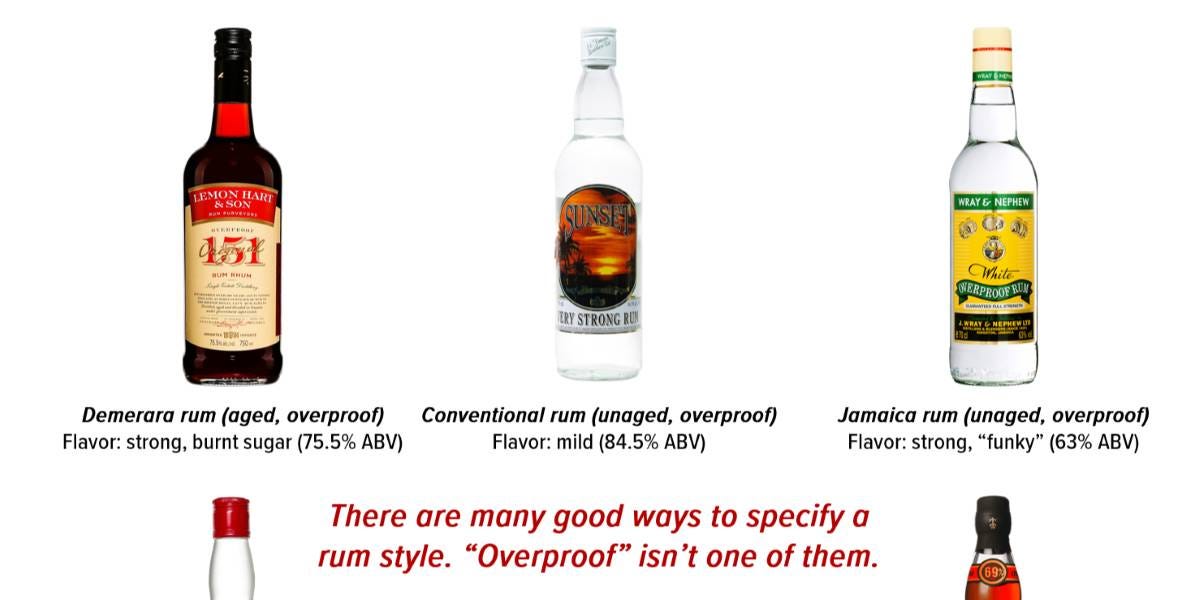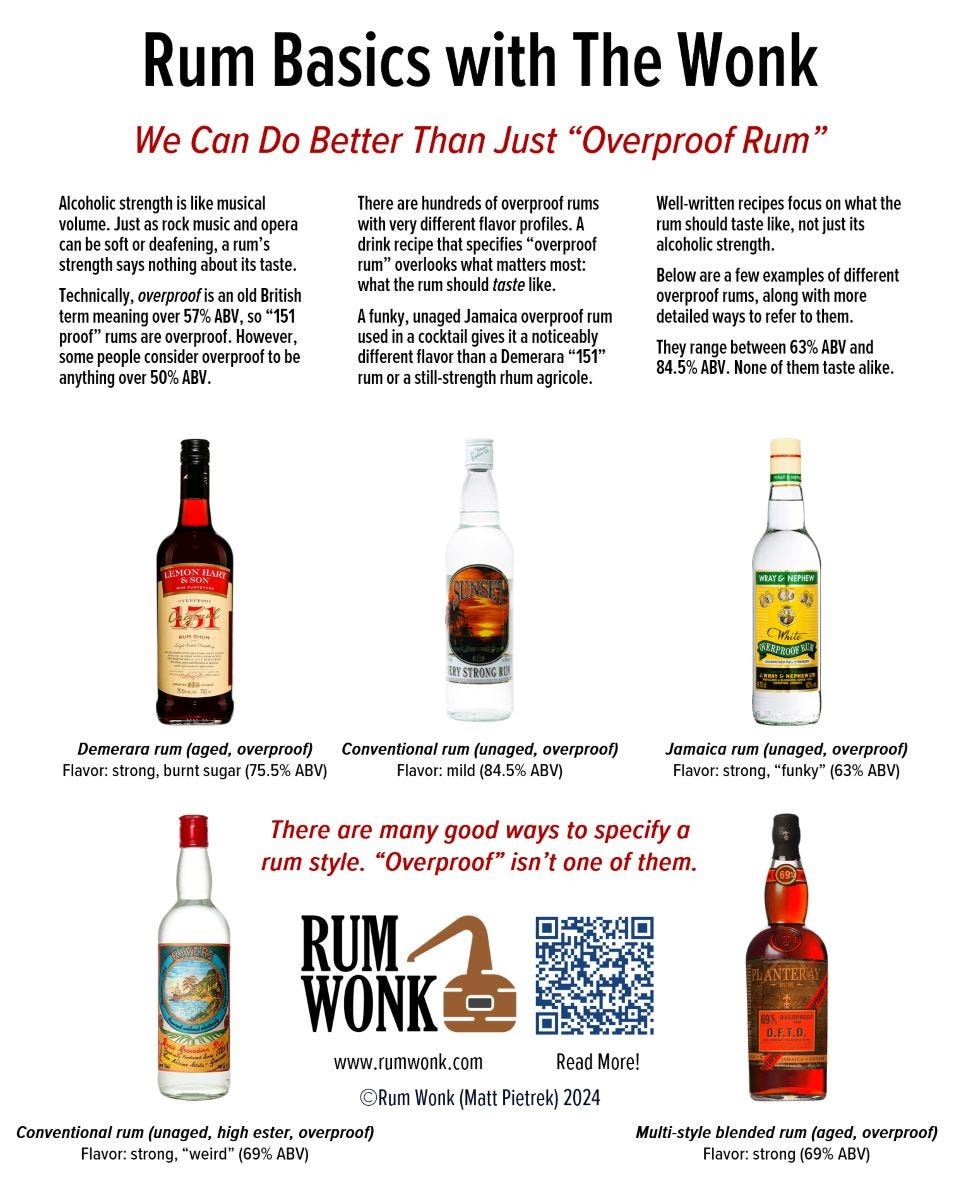We Can Do Better Than Just “Overproof Rum" - Infographic
Rum’s incredible diversity causes its greatest challenges: nebulous, ill-defined, and overly broad “styles.” Yes, I’m talking about gold rum, dark rum, French-style rum, et al. None of these threadbare styles convey what matters most—what it tastes like. Nor do they convey that rum is a meta-category of many well-defined and legally different spirits, just like how “whiskey” encompasses several national styles like Scotch whisky, Irish whiskey, etc.
Previously, I took aim at “white rum” as a style by way of an infographic. This time, I’m back with an infographic targeting “overproof rum.”
Alcoholic strength is just one of several important attributes that differentiate rums from each other. A recipe specifying a rum solely by its alcoholic strength is madness! That is unless the recipe’s only intent is getting you drunk — what it tastes like be damned!
A rum’s alcoholic strength (ABV) is like a song’s volume level. Volume by itself tells you nothing about what’s playing:
“Hey, what type of music do you like?”
“I don’t care as long as it’s over 100 decibels.”
ABV is also like a vehicle’s horsepower.
“What kind of car do you have?”
“315 horsepower.”
Mind you, my primary issue isn’t the overproof term itself. It has a historical origin from British excise collectors who centuries ago used gunpowder to “prove” that a spirit was over a specific strength — in today’s units, around 57% ABV. A spirit over that strength was called overproof.
My issue is that if “overproof” must be used, it should modify a more relevant description of the rum’s important attributes. For example, Jamaica rum (unaged, overproof) tells us:
Where the rum is from; Jamaica rums are known for their distinct flavor profiles
That the rum is unaged, so we shouldn’t be reaching for a bottle of Appleton 12, for instance
That it’s high strength. As it turns out, all four Jamaican rum producers sell bottled unaged rum at between 63% and 65% ABV.
Well-written recipes take care when specifying most types of rum, e.g., “Puerto Rican white rum,” “Dark Jamaican rum,” or “unaged rum agricole.” They give the reader a hint about what flavor profile to aim for. But for some reason, when it comes to high strength, that care often goes out the window:
Where was the rum made? Doesn’t matter, as long as it’s overproof.
What does the rum taste like? Doesn’t matter, as long as it’s overproof.
Is the rum aged? Doesn’t matter, as long as it’s overproof.
How strong should the rum be? Doesn’t matter, as long as it’s overproof.
Having stated why we can do better than just “overproof rum,” here’s the infographic:
Some will say that I’m tilting at windmills, and “why does it matter?” But rum’s reputation suffers because of the long-running lackadaisical approach to describing its styles. Nothing will change unless someone challenges the status quo by highlighting these problems and bringing more information to the table.
I always enjoy hearing from readers, so please comment in the comment section below!






You make a good case for further information - yet you fail to mention the collapse of Renegade Rum & Waterford Distillery that provided an overload of information & additional cost that the liquid inside the bottle didn’t live up to.
The high ABV is burning my mouth off - Doesn’t matter, it’s giving you all the information.
This rum tastes very similar to others I’ve tried - Doesn’t matter, it’s giving you all the information.
This whisky is young & feisty - Doesn’t matter, it’s giving you all the information.
I don’t care less what field it was grown in - Doesn’t matter, it’s giving you all the information.
What all that extra & expensive information cannot tell you is how your own individual palate will experience the spirit.
My palate tells me that & no amount of information on the bottle alters that.
Virtually every tasting of Renegade Rum or Waterford Whisky failed to set my tastebuds alight. I can only assume this was similar for other punters as ultimately not enough bottles were sold to protect the business.
So stop banging on about further information. Let folks palates decide what they like. Further information is a dead duck commercially as proven by the whole Terroir debacle.
om een ganse kudde schapen in beweging te krijgen heb je slechts een wel getrainde hond nodig .
Deze rol kan door de blenders en/of distilleerders ( diegenen die rum op de markt brengen ) op genomen worden.
Ik spreek over WEL getrainde ... wat inhoud klaar en duidelijke taal spreken op het etiket .
En niet willekeurige tekst die in de oren klinken om winst ( wat eigenlijk wel de bedoeling is ) ; zoals bevoordeeld je vorig post aangeeft .
Ik vind het bemoedens waardig dat je dit blijft aanhalen .